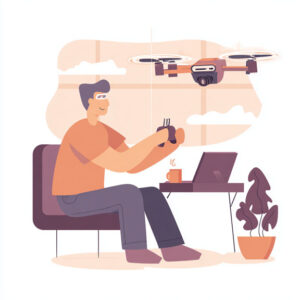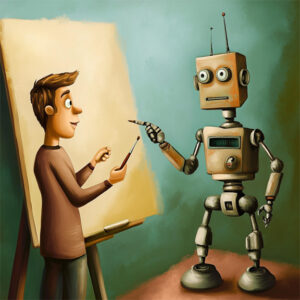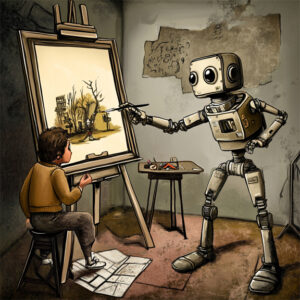 While people have been engaged in telework for quite some time, ever-improving technology will expand the range of jobs allowing for this long-distance labor. This raises a variety of interesting issues.
While people have been engaged in telework for quite some time, ever-improving technology will expand the range of jobs allowing for this long-distance labor. This raises a variety of interesting issues.
Some forms of telework are, by today’s standards, rather mundane and mostly non-controversial. For example, online classes are normal. Other jobs are more controversial, such as assassinating people with drones.
One promising (and problematic) area of teleworking is telemedicine. Currently, most telemedicine is primitive and mostly involves medical personal interacting with patients via video conferencing software (“take two aspirin and Zoom me in the morning”). Given that surgical robots exist, it is probably a matter of time before doctors and nurses routinely operate “doc drones” to perform medical procedures.
There are many positive aspects to such telemedicine. One is that doc drones will allow medical personnel to safely operate in dangerous areas. To use the obvious example, a doctor could use a drone to treat patients infected with Ebola while running no risk of infection. To use another example, a doctor could use a drone to treat a patient during a battle or occupation without risking being shot or blown up.
A second positive aspect is that a doc drone could be deployed in remote areas and places that have little or no local medical personnel. For example, areas in the United States that are currently underserved could be served by such doc drones. As the Trump regime devastates rural hospitals, telemedicine will become increasingly essential.
A third positive aspect is that if doc drones became cheap enough, normal citizens could have their own doc drone (with limited capabilities relative to hospital grade drones). This would allow for very rapid medical treatment. This would be especially useful given the aging populations in countries such as the United States.
There are, however, potential downsides to the use of doc drones. One is that the use of doc drones would allow companies to offshore and outsource medical jobs, just as companies have sent programing, manufacturing and technical support jobs overseas. This would allow medical businesses to employ lower paid foreign medical workers in place of higher paid local medical personnel. Such businesses could also handle worker complaints about pay or treatment simply by contracting new employees in countries that are worse off and hence have medical personal who are even more desperate. While this would be good for the bottom line, this would be problematic for local medical personnel.
It could be contended that this would be good since it would lower the cost of medical care and would also provide medical personnel in foreign countries with financial opportunities. In reply, there is obvious concern about the quality of care (one might wonder if medical care is something that should go to the lowest bidder) and the fact that medical personnel would have had better opportunities doing medicine in person. Naturally, those running the medical companies will want to ensure that the foreign medical personnel stay in their countries and this could be easily handled by getting Congress to pass tougher immigration laws, thus ensuring a ready supply of cheap medical labor.
Another promising area of telework is controlling military drones. The United States currently operates military drones but given the government’s love of contracting out services it is just a matter of time before battle drones are routinely controlled by private military contractors (or mercenaries, as they used to be called).
The main advantage of using military drones is that the human operators are out of harm’s way. An operator can also quickly shift operations as needed, which can reduce deployment times. Employing private contractors also yields numerous advantages, such as being able to operate outside the limits imposed by the laws and rules governing the military. There can also be the usual economic advantages. Imagine corporations profiting from being able to keep wages and benefits for the telesoldiers very low. There is, of course, the concern that employing foreign mercenaries might cause serious problems, but perhaps one should just think of the potential shareholder and executive profits and let the taxpayers worry about paying for any problems.
There are other areas in which teleworking would be appealing. Such areas are those that require the skills and abilities of a human and cannot simply be automated yet can be done via remote control. Teleworking would also need to be cheaper than hiring a local human to do the work. Areas such as table waiting, food preparation, and retail will most likely not see teleworkers replacing low-paid local workers. These jobs are likely to be automated. However, areas with relatively high pay could be worth the cost of converting to telework.
One obvious example is education. While the pay for American professors is relatively low and most professors are now underpaid adjuncts, there are people outside the United States who would be happy to work for even less. Running an online class, holding virtual office hours and grading work just requires a computer and an internet connection. With translation software, the education worker would not even need to know English to teach American students.
Obviously enough, since administrators would be making the decisions about whose jobs get outsourced, they would not outsource their jobs. They would remain employed. In fact, with the savings from replacing local faculty they could give themselves raises and hire more administrators. This would progress until the golden age of education is reached: campuses populated solely by well-paid administrators.
Construction, maintenance, repair and other such work might be worth converting to telework. However, this would require machines that are cheap enough to justify hiring a low paid foreign worker over a local worker. However, a work drone could be operated round the clock by shifts of operators (aside from downtime for repairs and maintenance) and there would be no vacations, worker’s compensation or other such costs. After all, the population of the entire world would be the workforce and any workers that started pushing for better pay, vacations or other benefits could be replaced by others who would be willing to work for less. If such people become difficult to find, a foreign intervention or two could set things right and create an available population of people desperate to do telework.
Large scale telework would also seem to lower the value of labor since the competition among workers would be worldwide. A person living in Maine who applied for a telejob would be up against people from Argentina to Zimbabwe. While this will be great for the job creators, it will probably be less great for the job fillers.
While this dystopian (from the perspective of the 99%) view of telework seems plausible, it is also worth considering that telework might be beneficial to the laboring masses. After all, it would open opportunities around the world and telework would require stable areas with adequate resources such as power and the internet. So companies would have an interest in building such infrastructure. As such, telework could make things better for some workers. Telework would also be relatively safe, although it could require very long hours and impose stress.
Telework can also build the foundation for full automation, replacing the human operator with AI. The conversion would only involve the cost of the AI, since it could simply interface with the existing hardware. For example, a dronedoc would go from being controlled by a human doctor to being controlled by DrGPT.

 Mass shootings occur with such frequency that there is a well-established script for everyone. The media focuses on the weapon used, the right offers “thoughts and prayers” and says now is not the time to talk about gun violence, and the left calls for more gun control. Attention will then fade; children will be buried and nothing significant will be done. This cycle will repeat with the next mass shooting. And the next. As a country, we are getting it wrong in many ways.
Mass shootings occur with such frequency that there is a well-established script for everyone. The media focuses on the weapon used, the right offers “thoughts and prayers” and says now is not the time to talk about gun violence, and the left calls for more gun control. Attention will then fade; children will be buried and nothing significant will be done. This cycle will repeat with the next mass shooting. And the next. As a country, we are getting it wrong in many ways. While analogies, like cars, always break down eventually, they can be useful. While running, I thought about my injury-induced lack of racing trophies and my oxygen deprived brain tied this into the division of goods in capitalism. Hence, this analogy between running races and capitalism.
While analogies, like cars, always break down eventually, they can be useful. While running, I thought about my injury-induced lack of racing trophies and my oxygen deprived brain tied this into the division of goods in capitalism. Hence, this analogy between running races and capitalism. Thanks to The Terminator, people think of a Skynet scenario as the likely AI apocalypse. The easy and obvious way to avoid a Skynet scenario is don’t arm the robots. Unfortunately, Anduril and OpenAI seem intent on “doing a Skynet” as
Thanks to The Terminator, people think of a Skynet scenario as the likely AI apocalypse. The easy and obvious way to avoid a Skynet scenario is don’t arm the robots. Unfortunately, Anduril and OpenAI seem intent on “doing a Skynet” as  As noted in my previous essay, a person does not surrender their moral rights or conscience when they enter a profession. It should not be simply assumed that a health care worker cannot refuse to treat a person because of the worker’s values. But it should also not be assumed that the values of a health care worker automatically grant them the right to refuse treatment based on the identity of the patient.
As noted in my previous essay, a person does not surrender their moral rights or conscience when they enter a profession. It should not be simply assumed that a health care worker cannot refuse to treat a person because of the worker’s values. But it should also not be assumed that the values of a health care worker automatically grant them the right to refuse treatment based on the identity of the patient. Joining a profession can complicate a person’s ethical situation. For example, lawyers are obligated to defend their clients even if their client is a moral monster. In the case of health care workers, moral complications can arise when they are expected to perform medical procedures they oppose on moral or religious grounds. They can also arise when they are asked to treat a patient when they have an objection to treating patients of that type, such as a transgender person or a CEO. There is the ethical issue of whether a health care worker has the right to refuse to perform a procedure or treat a patient based on these religious or moral objections.
Joining a profession can complicate a person’s ethical situation. For example, lawyers are obligated to defend their clients even if their client is a moral monster. In the case of health care workers, moral complications can arise when they are expected to perform medical procedures they oppose on moral or religious grounds. They can also arise when they are asked to treat a patient when they have an objection to treating patients of that type, such as a transgender person or a CEO. There is the ethical issue of whether a health care worker has the right to refuse to perform a procedure or treat a patient based on these religious or moral objections. AI generated works have already disrupted the realm of art. As noted in the previous essay, this is a big problem for content art (art whose value is derived from what it is or how it can be used). However, I will show that named art might enjoy some safety from AI incursions.
AI generated works have already disrupted the realm of art. As noted in the previous essay, this is a big problem for content art (art whose value is derived from what it is or how it can be used). However, I will show that named art might enjoy some safety from AI incursions. This essay changes the focus from defining art to the economics of art. This discussion requires making a broad and rough distinction between two classes of art and creators. The first class of art is called “named art.” This is art whose value derives predominantly from the name and fame of its creator. Works by Picasso, van Gogh, Rembrandt and the like fall into this category. Artists who are enjoying a fleeting fame also fall into this category, at least so long as their name is what matters. This is not to deny that such art can have great and wonderful qualities of its own; but the defining feature is the creator rather than the content.
This essay changes the focus from defining art to the economics of art. This discussion requires making a broad and rough distinction between two classes of art and creators. The first class of art is called “named art.” This is art whose value derives predominantly from the name and fame of its creator. Works by Picasso, van Gogh, Rembrandt and the like fall into this category. Artists who are enjoying a fleeting fame also fall into this category, at least so long as their name is what matters. This is not to deny that such art can have great and wonderful qualities of its own; but the defining feature is the creator rather than the content. While it is reasonable to consider the qualities of the creator when determining whether a work is art, it also makes sense to consider only the qualities of the work. On this approach, what makes a work art are the relevant qualities of that work, whatever these qualities might me. It also makes sense to consider that the effect these qualities on the audience could play a role in determining whether a work is art. For example,
While it is reasonable to consider the qualities of the creator when determining whether a work is art, it also makes sense to consider only the qualities of the work. On this approach, what makes a work art are the relevant qualities of that work, whatever these qualities might me. It also makes sense to consider that the effect these qualities on the audience could play a role in determining whether a work is art. For example,